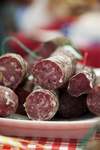French Sausage
French sausage is made all over the country and many regions boast their own speciality. As always with French food, I recommend you learn a little and then get out there and enjoy.
Saucisse vs. Saucisson
To enjoy French sausage, you first need to understand a few terms. Unfortunately, even the French are not entirely clear on the subject, but here is what seems to work most of the time:

Saucisson Sec
Saucisse - A soft, moist, sausage that needs to be cooked before it can be eaten. It must be refrigerated and it has a fairly short shelf life. It will many times be used as an ingredient in recipes.
Saucisson sec - This is a cured raw sausage. It is fairly dry and can be cut in thin slices. An uncut saucisson sec does not require refrigeration, rather it should be hung in a cool dry location. This type of French sausage is often enjoyed on its own or with just a few garnishes.
Saucisse cuite - This is a sausage that has already been cooked before it is sold. It is eaten cold or perhaps poached.
Charcuterie - Charcuterie refers to any number of elaborated meat products. These include sausages, but also terrines, patés, rillettes, pickled meats, hams, and more. If you get a chance, be sure to visit a quality charcuterie shop while in France. You will be amazed at the truly wondrous display of food, including a lovely variety of French sausage.
Popular French Sausage
Andouilette - This is a really different sort of sausage. It has a very rough texture and is made from chopped chitterlings (a cute little name for pig intestines), as well as any number of a variety of secondary ingredients. It is normally already cooked when sold and is then heated in any number of fashions including grilling, pan frying, or baking. Some people even enjoy it cold!

Boudin Blanc- These are very soft and finely textured. They are made from white meat (pork, chicken and/or veal), a little milk, and some seasoning. They contain no blood at all. These often come already cooked and can be gently pan fried in a little butter and served simply with mashed potatoes.
Boudin Noir - This is a blood sausage - pork blood being the main ingredient. Various other ingredients might flavor the boudin, including apples, prunes, raisins or chestnuts. Only eat boudin noir that is very fresh and serve it piping hot. It can be grilled or pan fried.
Cervelas - This sausage originated in Switzerland but is very popular in Alsace. It is fat and juicy and its ends are usually sliced in a cross so that it fans out while it is cooked. It is also sold already cooked, in which case it might be eaten cold in a salad.
Figatellu - A speciality of Corsica, this dried sausage is made from pork liver and a lot of garlic. Some people enjoy it raw, but it is also many times grilled or cooked in a sauce.
Merguez and Chipolatas - If someone is having a barbecue in France, you can bet that these two smaller sized sausages will be side by side on the grill. Originally from northern Africa, a merguez is normally made from lamb, although beef may be included (no pork). It contains spices that give it a dark red cast. The merguez's best friend, the chipolata, is made from pork and is many times seasoned with herbs.
Saucisse de Morteau - This is a smoked sausage that comes from the region of Franche-Comté in the eastern part of France. Its production is governed by an IGP (indication géographique protégée), meaning that to be labeled a saucisse de Morteau, the sausage must be made in a certain fashion. Usually sold uncooked, it should be simmered in water (starting with cold water so that it heats up gently). It is easily recognized by the small piece of wood (called a cheville) used to close it on one end.
Saucisse de Montbéliard - A juicy sausage that is typically cooked in boiling water. It too comes from Franche-Comté and is similar to the Morteau. The Montbéliard however is smaller, less smokey and not quite so fatty.
Saucisse de Strasbourg and Saucisse de Francfort - These look and taste pretty much like what a lot of people consider a hot dog. The texture is very fine and the color can be a rather alarming red for the saucisse de Strasbourg. These are many times used as an ingredient in choucroute garnie (sauerkraut or pickled cabbage served with potatoes and a variety of meats).
Saucisse de Toulouse - These typically appear as an ingredient in cassoulet, a hearty white bean stew that is a speciality from the south western part of France. An easier way to enjoy this mild tasting pork sausage is to simply pan fry it.
Saucisson de Lyon - It seems to me that this should be called a saucisse, but it isn't. Don't confuse it with the Rosette de Lyon, a dry cured pork sausage that is more similar to salami. This saucisson must be cooked and is served in any number of ways including on top of a bed of lentils or wrapped in a brioche bread.
Finding French Sausage
You may not be able to find many of these French sausages where you live, but hopefully you will get a chance to sample some. If you do have access to a high quality butcher he may be able to steer you in the right direction when looking for substitutes.
For those of you brave enough, here is a website that includes directions for making several of the more popular French sausage: Hertzmann.
Other than that, might I suggest a trip to France?
Hungry for more? Go from French sausage to French Foods.

New! Comments
Have your say about what you just read! Leave me a comment in the box below.